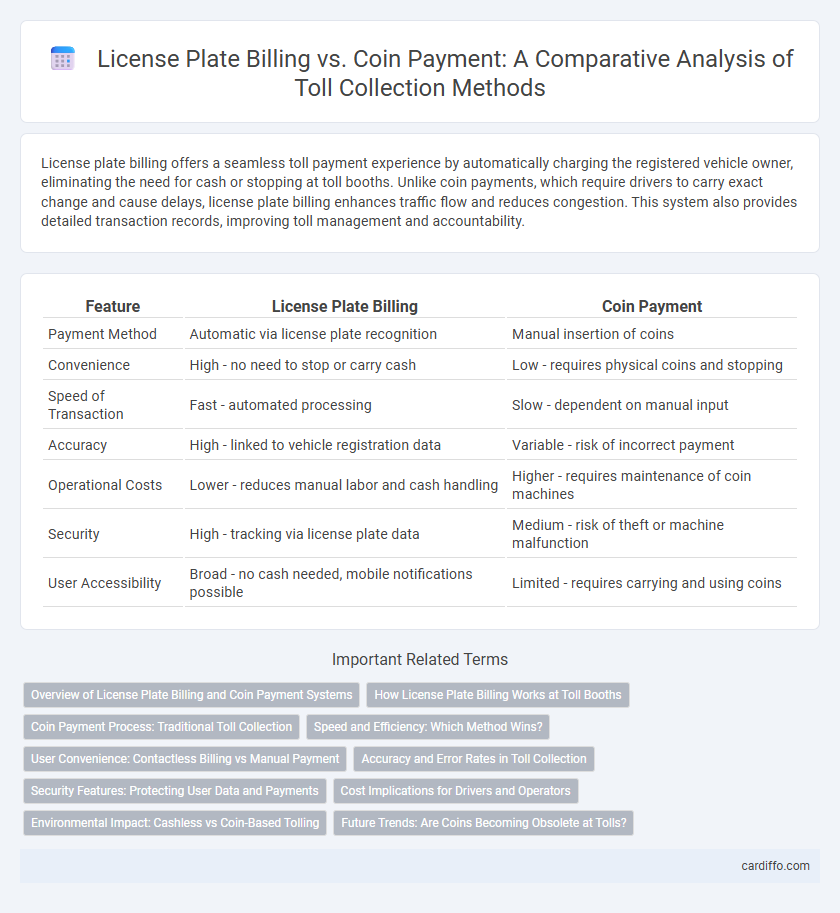License plate billing offers a seamless toll payment experience by automatically charging the registered vehicle owner, eliminating the need for cash or stopping at toll booths. Unlike coin payments, which require drivers to carry exact change and cause delays, license plate billing enhances traffic flow and reduces congestion. This system also provides detailed transaction records, improving toll management and accountability.
Table of Comparison
| Feature | License Plate Billing | Coin Payment |
|---|---|---|
| Payment Method | Automatic via license plate recognition | Manual insertion of coins |
| Convenience | High - no need to stop or carry cash | Low - requires physical coins and stopping |
| Speed of Transaction | Fast - automated processing | Slow - dependent on manual input |
| Accuracy | High - linked to vehicle registration data | Variable - risk of incorrect payment |
| Operational Costs | Lower - reduces manual labor and cash handling | Higher - requires maintenance of coin machines |
| Security | High - tracking via license plate data | Medium - risk of theft or machine malfunction |
| User Accessibility | Broad - no cash needed, mobile notifications possible | Limited - requires carrying and using coins |
Overview of License Plate Billing and Coin Payment Systems
License plate billing leverages automatic license plate recognition (ALPR) technology to capture and invoice vehicles based on their registration numbers, enabling seamless toll collection without stopping. Coin payment systems rely on manual insertion of coins at toll booths, requiring physical interaction and potentially causing traffic delays. The license plate billing system enhances efficiency, reduces congestion, and eliminates the need for drivers to carry exact change, while coin payments offer a straightforward but less efficient alternative.
How License Plate Billing Works at Toll Booths
License Plate Billing at toll booths uses automated cameras to capture vehicle license plates as they pass through, linking the plate number to the registered owner's account for electronic billing. This system eliminates the need for physical cash transactions by matching the license plate data with a prepaid or postpaid toll account. Enhanced with OCR technology and real-time data processing, license plate billing streamlines traffic flow and reduces congestion compared to traditional coin payment methods.
Coin Payment Process: Traditional Toll Collection
Coin payment in traditional toll collection involves drivers manually inserting coins into toll booths, enabling immediate transaction completion without the need for electronic devices. This process relies on physical currency, requiring toll attendants or automated coin acceptors to verify and process payments on-site. Despite the simplicity of coin payment, it often leads to slower traffic flow and increased congestion compared to automated license plate billing systems.
Speed and Efficiency: Which Method Wins?
License plate billing significantly outperforms coin payment in speed and efficiency by eliminating the need for vehicles to stop and manually insert coins at toll booths. Automated recognition systems enable seamless transaction processing, reducing congestion and wait times during peak hours. Coin payment's reliance on physical interaction slows traffic flow and increases the risk of human error, making license plate billing the superior method for optimizing toll operations.
User Convenience: Contactless Billing vs Manual Payment
License plate billing enhances user convenience by allowing seamless, contactless toll payments without the need for physical interaction or carrying coins. Coin payment requires manual insertion at toll booths, causing potential delays and inconvenience during busy traffic hours. With license plate billing, transactions are automated and quicker, reducing wait times and improving overall traffic flow at toll plazas.
Accuracy and Error Rates in Toll Collection
License plate billing systems reduce error rates by automating vehicle identification through high-resolution cameras and advanced optical character recognition technology, which minimizes human intervention. Coin payment methods are prone to inaccuracies due to mechanical failures, coin jams, and human errors in change handling, leading to higher transaction errors and slower processing times. Enhancing toll collection accuracy, license plate billing improves revenue assurance and reduces customer disputes compared to traditional coin-based toll booths.
Security Features: Protecting User Data and Payments
License Plate Billing enhances security by encrypting vehicle and payment data, reducing the risk of fraud compared to physical coin transactions prone to theft or tampering. This system uses secure cloud-based platforms to store and process user information, ensuring compliance with data protection regulations such as GDPR. Coin payment methods lack advanced fraud detection and often expose users to privacy risks due to untraceable cash handling.
Cost Implications for Drivers and Operators
License Plate Billing reduces operational costs for toll operators by eliminating the need for physical toll booths and cash handling infrastructure, resulting in lower maintenance expenses and streamlined backend processing. For drivers, License Plate Billing often incurs higher per-transaction fees compared to coin payments, but it enhances convenience by enabling seamless, cashless travel without stopping. Coin payment decreases upfront toll fees yet introduces delays and higher labor costs for operators managing cash transactions, impacting overall system efficiency and potentially increasing long-term expenses.
Environmental Impact: Cashless vs Coin-Based Tolling
Cashless tolling through license plate billing significantly reduces environmental impact by eliminating the need for physical toll booths and the associated vehicle idling, which decreases carbon emissions. Coin-based tolling requires vehicles to stop or slow down at toll plazas, increasing fuel consumption and air pollution. Transitioning to cashless systems supports greener transportation infrastructure and promotes sustainable toll collection practices.
Future Trends: Are Coins Becoming Obsolete at Tolls?
License plate billing is rapidly replacing coin payment systems at toll plazas due to its efficiency and reduced operational costs. Advances in automatic license plate recognition (ALPR) technology enable seamless toll collection without stopping, promoting faster traffic flow and lower maintenance expenses compared to coin-operated machines. As digital payment adoption increases and infrastructure modernizes, the use of coins at tolls is becoming obsolete, signaling a shift towards fully automated, cashless tolling systems.
License Plate Billing vs Coin Payment Infographic

 cardiffo.com
cardiffo.com